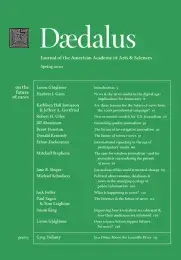Are there lessons for the future of news from the 2008 presidential campaign?
When news does its job, attentive citizens are better able to understand both the challenges facing the country and the competing visions of those seeking to lead it. Indeed, some argue that “the purpose of journalism is to provide people with the information they need to be free and self-governing.”1 In years past, those studying media have reliably found that consumers of traditional news were better informed about issues of national concern.2 However, the growth of a new media culture in which partisans are able to envelop themselves in like-minded content raises a question: in the world of ideologically tinged cable news, opinion-talk radio, and viral email, does news in any of its various incarnations still sift fact from fabrication and, in the process, heighten a voter’s knowledge about those aspiring to lead?
Our study of the presidential general election campaign of 2008 suggests that traditional news sources are not the custodians of fact that they once were. At the same time, sources that blend discussion of news with what we call opinion-talk are at least occasional purveyors of unbalanced issue coverage and misinformation. In this transformed media environment, presidential debates hold up as one of the only venues, if not the sole source, that heightens citizens’ campaign knowledge. These conclusions arise from our study of how newspapers, national and local broadcast and cable news, Internet, talk radio, and debate audiences responded to questions about the central deceptions advanced by the major party candidates.
In the general presidential election of 2008, viewers in battleground states were assaulted by deceptive claims, among them that Arizona Senator and Republican Party nominee John McCain wanted to cut Social Security and stay in Iraq for one hundred years and that Illinois Senator and Democratic Party nominee Barack Obama did not take Iran seriously and had a close relationship with former Weather Underground leader William Ayers.3 The two most prevalent distortions, each backed by multimillion-dollar ad buys, involved taxation. Specifically, the Democrats alleged that McCain would impose a net tax on health care benefits, and the Republicans insisted that Obama would raise taxes on working families including “yours.” Where the Obama campaign spent $43 million on broadcast ads asserting the first claim, the McCain campaign devoted $53 million to spots alleging the second.1
. . .
